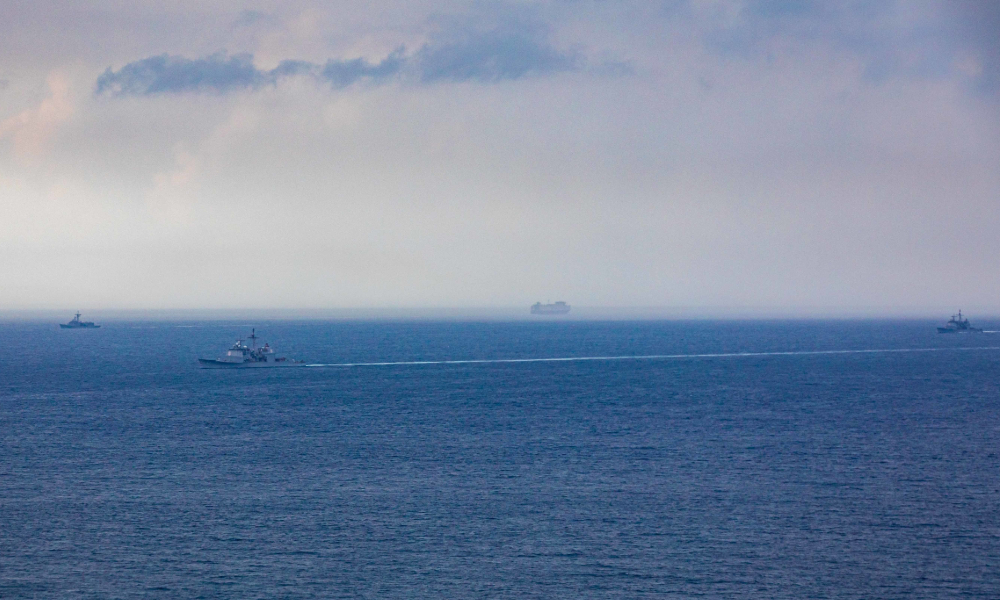The Geography of a U.S.-China War

Published by The Lawfare Institute
in Cooperation With

Editor’s Note: The security world is replete with Cold War analogies when assessing the U.S. competition with China. Henrik Stålhane Hiim and Øystein Tunsjø of the Norwegian Institute for Defence Studies argue that this comparison is dangerously misleading. The geography of Asia and the strategic value of Taiwan differ considerably from the Europe-focused Cold War, and conflict, including the possible use of nuclear weapons, is far more likely as a result.
Daniel Byman
***
Persisting tensions between the United States and China have led observers to warn of a new Cold War. Although meant to convey alarm, the comparison contains a measure of reassurance. Despite ferocious competition and recurring crises, the Cold War was a period of unprecedented peace between the superpowers. If the analogy holds, U.S.-China rivalry will dominate international politics in the coming decades, but a hot war will be unlikely.
Key features that prevented a major war between the Cold War superpowers are also present today. The fear of nuclear annihilation that instilled caution in Moscow and Washington then should stay the hands of Chinese and U.S. leaders now. With China’s immense growth, the international system is arguably returning to a bipolar distribution of power on par with the Cold War, and bipolar systems are more stable than multipolar ones.
Yet such comparisons obscure a critical difference: geography. Whereas the Cold War center of gravity was the land theater of Central Europe, the U.S.-China rivalry is unfolding in maritime East Asia, with Taiwan its most serious flashpoint. In a maritime theater, it is easier to keep a war limited than in a conflict on land. Paradoxically, this lowers the threshold for going to war. To make matters worse, the threshold for limited use of nuclear weapons is also lower in a maritime theater.
As we highlight in a new article in International Security, these geographic differences have profound implications. Although geography is not destiny, maintaining peace in the coming decades will likely be more challenging than during the Cold War superpower rivalry. It requires a U.S. deterrence strategy that differs from the Cold War playbook.
The Cold War Geography of Peace
During the Cold War, Western leaders feared aggression from the Soviet Union. These fears intensified during the early 1960s, when the Soviet Union developed a nuclear second-strike capability. With a more robust nuclear arsenal, the Soviet Union could rely on its overwhelming conventional strength and attempt an incursion into Europe while deterring U.S. intervention and preventing escalation to an all-out nuclear conflagration.
Yet as limited war theorists pointed out, geography served as a powerful brake on Soviet adventurism because no war there would stay limited. Central Europe was a compact land theater with large numbers of military targets and heavy urban concentrations. If war had broken out, it would likely have unfolded quickly, the number of military and civilian casualties would have been high, and discrimination between tactical and strategic targets would have been very difficult. Both Soviet and Western leaders recognized that keeping a war within limits and avoiding all-out nuclear war would have been extremely challenging.
The same geography also made the stakes in such a conflict very high. For the United States, the Soviet Union subjugating Europe would have been a geopolitical disaster. For this reason, U.S. security guarantees, including trip wire forces and nuclear threats, had an inherent credibility.
Taiwan and the East Asian Geography of War
Unlike Cold War Europe, the U.S.-China rivalry is manifesting at sea. The United States lacks a strong military presence on the East Asian mainland, and all of its most important partners and allies are separated from China by bodies of water or a buffer zone, such as North Korea. Projecting power over water is extremely challenging. Thus, China does not represent an existential threat to U.S. allies or partners. Taiwan is an exception, in part because of its relative proximity to the mainland but most importantly because Chinese leaders regard the island as a renegade province, and have tasked the People’s Liberation Army (PLA) to prepare unification through force if necessary. Although Beijing’s control of Taiwan would undoubtedly be a bad outcome for the United States, the U.S. stakes in the conflict are certainly not existential.
Somewhat counterintuitively, the lower U.S. stakes make conflict over Taiwan more likely. Chinese leaders could convince themselves—rightly or wrongly—that the United States will stay out if they attack Taiwan. There are no U.S. trip wire forces on the island, and the United States has not provided Taiwan with ironclad security guarantees. If the United States were to intervene, U.S. leaders would likely be cautious about escalation risks—and Beijing could therefore hope to keep the conflict confined. In other words, the lower U.S. stakes in a Taiwan conflict may influence whether and how the United States fights China.
The geography of maritime East Asia facilitates reaching tacit bargains about limits to a war. Taiwan is an integral territorial unit, and both sides may believe they could limit the conflict to the island and the skies and waters surrounding it. To be sure, both China and the United States would have to make difficult trade-offs when fighting a war. The United States would have to consider whether attacks against targets on the Chinese mainland would trigger escalation, and Chinese leaders would have to consider whether U.S. bases in Japan and elsewhere in the region—as well as the U.S. territory of Guam—are off limits or not. Nevertheless, there is no reason for a conflict to automatically escalate to the broader region.
Going Nuclear, Within Limits
If a limited conventional war were to break out in East Asia, limited nuclear use is more likely than it was in Cold War Europe. The threshold for going nuclear is still likely to be very high—not least because of the risk of further escalation—but it is more probable in a conflict over Taiwan than it was in Cold War Europe.
Geographic differences are the most important reason why limited nuclear use is more likely in current-day East Asia. Although both the United States and the Soviet Union developed massive inventories of so-called tactical nuclear weapons, keeping limits on a nuclear war in the dense land theater of Central Europe was a chimera. According to research conducted during the early 1980s, NATO would have needed to set off hundreds of battlefield nuclear weapons to stop a significant amount of the Soviet Union’s 20,000 tanks in a war in the Germanies. The result would have been a million people killed, if not more—and, in all likelihood, further escalation.
In contrast, the number of high-value military targets in East Asia is much more limited, and some are not located near cities or other population centers. China and the United States could limit their targets to surface vessels, such as an aircraft carrier or some military bases and ports. U.S. analysts have also debated whether China or the United States could strike targets on Taiwan, such as landing zones on the island. Unlike Cold War Europe, a more limited number of nuclear strikes could have a material impact on the war. Moreover, both China and the United States possess highly accurate nuclear weapons, which facilitates avoiding indiscriminate damage.
Partly for these reasons, China and the United States increasingly worry that the other may employ nuclear weapons in a war over Taiwan. As the U.S. Department of Defense has highlighted, Chinese leaders have been concerned since 2018 that the United States “would use low-yield weapons against a Taiwan invasion fleet.” Similarly, U.S. analysts fear that China could threaten or even conduct limited nuclear strikes if it was on the brink of losing a conflict.
Think Globally, Deter Locally
A conflict in East Asia could stay limited, but its impact on the world would still be enormous. Even if it does not escalate beyond Taiwan, war games indicate that it would take a heavy toll on both the U.S. and Chinese militaries. It would also be disastrous for Taiwan’s population. Moreover, the fallout for the world economy would be vast.
During the Cold War, the United States relied extensively on nuclear deterrence to keep the Soviet Union in check. That strategy is not directly applicable today. In a limited war, Chinese leaders may not regard U.S. nuclear threats as credible: U.S. defense planners do not seem willing to trade New York for Taipei. Although nuclear weapons will still play a role, the key to preserving peace in the new superpower rivalry is to ensure that the local conventional power balance does not tilt too far in China’s direction.
In recent years, that balance has shifted in China’s direction, particularly in the Taiwan Strait. Left unchecked, Chinese leaders may at some point believe they can win a conflict and force “reunification” with Taiwan. But despite the spectacular growth in Chinese military might during the last decades, projecting power across the strait remains a daunting task for the PLA. Amphibious landings are highly complex military operations, and because of Taiwan’s geography, the PLA would have to concentrate its forces near a few beach heads, where they would be vulnerable. Even if the PLA manages to land, securing control over an island of 23 million people—and possibly facing both heavy urban and guerrilla warfare—would require a large force.
The United States can help Taiwan prepare. By supplying Taiwan with capabilities that can target a landing force, such as anti-ship missiles, and by continuing to train its forces to fight on the island, the United States can help maintain deterrence. It also has a strong ally in Japan and other maritime allies and partners that can contribute to deterring China. To reduce the risks of limited war, a strenuous, enduring effort by the United States to help counterbalance China’s conventional military might is required.




